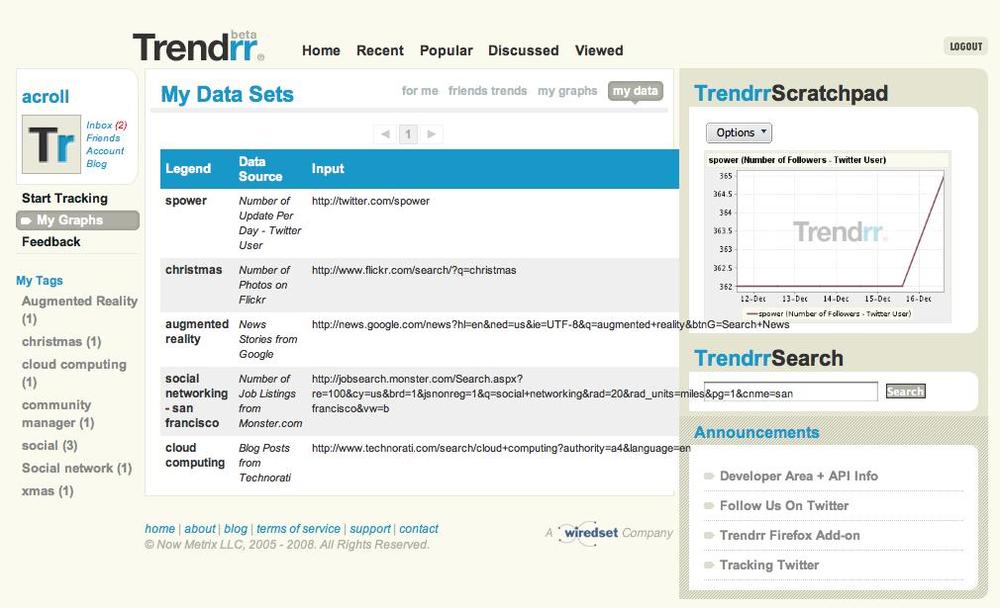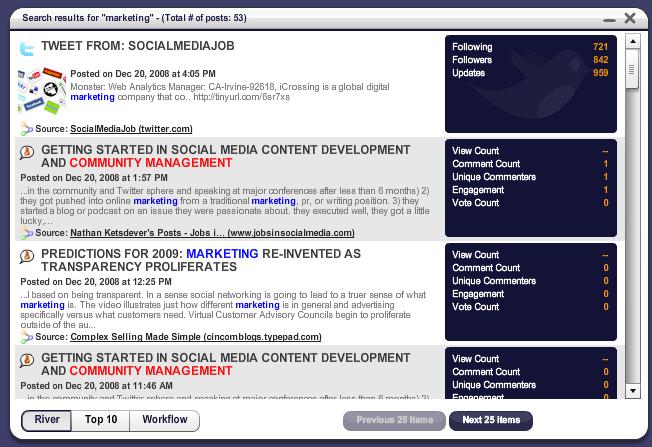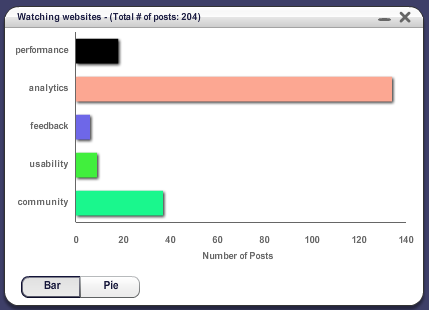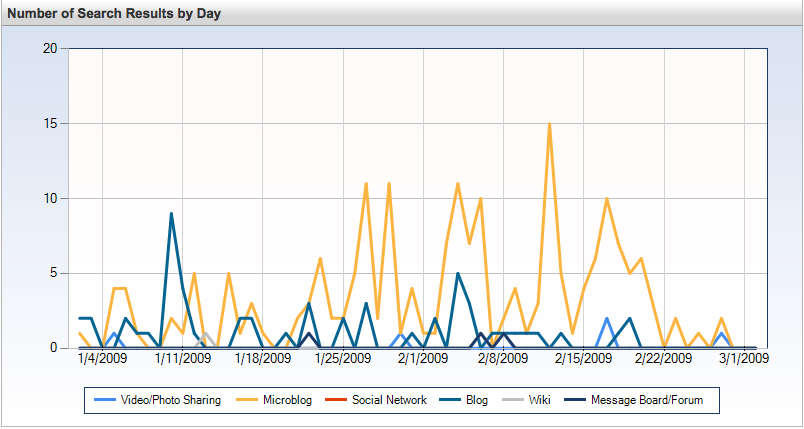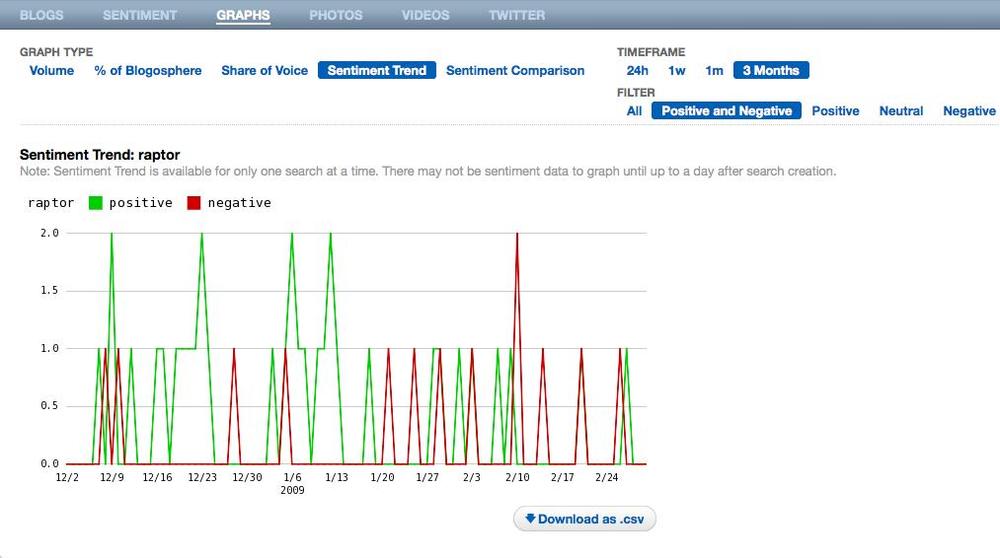Clearly, there’s a tremendous amount of work required to find, engage, and report on communities. If you just consider the eight communities we’ve seen, and the four ways you can get involved (search, enrollment, moderation, and running them), and the options to report, join, amplify, or contact members within a community, you have a daunting number of possibilities. Multiply this by the thousands of messages you might receive, and there’s no way to keep up manually.
There are several tools and techniques for tracking your community presence. First of all, you can use consolidated reporting sites like Trendrr, shown in Figure 14-56, to collect and report on a variety of metrics.
Figure 14-56. Trendrr is a general-purpose tool for tracking multiple sources of online data in a single place
Many commercial platforms, such as Radian6, Techrigy, ScoutLabs, BuzzMetrics, Sysomos, and BuzzLogic, provide reports and automate many of the search techniques we’ve outlined here (we’re convinced that the term “buzz” has been forever claimed by this segment of the monitoring industry). Still other services and tools focus on bulk messaging and automated responses to handle a growing number of direct interactions between a company and its communities.
Regardless of the vendor, community monitoring tools do three basic things:
Find conversations across many community platforms and websites
Aggregate the content into digestible chunks and visualizations, sometimes detecting sentiment, demographics, and attitudes
Manage your responses to what’s happening in the community
To collect all of the conversations happening on the Internet, social listening platforms use a variety of techniques. While they might rely on search engines like Google, many prefer their own collection systems. They run web crawlers that index websites and look for keywords. They subscribe to RSS feeds. And they harvest data from the APIs of micromessaging services like Twitter. Ultimately, they’ll collect conversations and content from the many platforms we’ve looked at, but will usually stop short of joining those platforms on your behalf.
The use of crawlers for community monitoring is a controversial subject. To provide a real-time understanding of what communities are up to, these crawlers index sites more frequently than those of large search engines like Google, which can put additional load on servers. What really earns them the wrath of some website operators, however, is the fact that they crawl aggressively: they want to find any mention of a conversation, anywhere on the Web, even when told not to.
Most websites tell crawlers which pages on the site can be indexed
through a file called robots.txt. This file specifies the pages that the crawler may
traverse and those that it should leave alone. There are several reasons
a site operator may not want crawlers to index the site. The site
operator may want to force visitors to come to his sites to find content
rather than finding it through an external search engine; he may not
want the additional load; or the pages may be dynamic and subject to
frequent changes.
Some social listening platforms’ crawlers have been accused of
ignoring robots.txt, or of using
user agents that hide their true identities (http://web-robot-abuse.blogspot.com/2008/05/wwwradian6comcrawler.html).
This is a violation of the site’s terms of use, and some site operators
go to lengths to block such crawlers through other means.
Once they’ve collected the thousands of conversations that might matter to you, community monitoring tools try to make sense of them so that the important interactions rise to the top. This takes several forms, including rivers of news, keyword summaries, influencer scores, threading and drill-downs to individuals, and time graphs.
A river of news is a lifestream for the topics you’ve flagged as important, as shown in Figure 14-57. You can segment the river by platform, most popular topics, or most influential participants. This serves as a good real-time visualization of how people are discussing your brand or topics online, as well as where those conversations are happening. You can often drill down to individuals participating in the conversations.
Rather than viewing community activity as a feed of news, you may want to aggregate conversations by keywords over time. You can compare specific terms within a certain topic for popularity, as shown in Figure 14-58.
Choosing the right words within a segment, such as product names, helps you estimate the relative popularity of particular topics or assess overall mood across communities. Be careful not to read too much into such results: without context, the results may be misleading. It’s much better to visit the places you’re being discussed and get a sense of what’s happening, rather than relying on how often a particular word is mentioned.
You can also view graphs that show you the distribution of keywords across social media channels (Figure 14-59).
Figure 14-59. The Share of Voices report in Techrigy’s SM2 product shows the number of times people have searched for a particular subject
Every mention on a community has someone behind it, and some community members are more influential. This is the “who’s talking” part of things. Perhaps they have more followers, a better Technorati ranking, more page views according to Compete.com, more influence on Klout.net, or a bigger social graph in OpenSocial. Whatever the case, you need to identify key influencers who are discussing you.
Figure 14-60 shows an influencer report that lets you compare the people contributing to topics you care about.
Once you’ve identified an important influencer, regardless of his social network or the platform he’s using, you’ll want to learn more about him. Many of the community management tools available today will mine multiple social networks, as well as public social graphs like OpenSocial, to build a profile of your influencers (Figure 14-61).
It’s not enough to know which topics are important and who’s talking about them. You will also want to understand the trends of particular topics within a community or the blogosphere at large, as shown in Figure 14-62.
Historical trend analysis of this kind can be overlaid with analytical data to see whether a spike in community traffic corresponds to a rise in site traffic or goal conversions. You can also use this kind of analysis to compare competitors and see who’s pulling ahead.
While it’s fine to see mentions of a topic, it’s just as important to understand the context in which those mentions occurred: was the sentiment positive or negative?
Evaluating sentiment requires that a machine parse online mentions and assign it a score—positive, negative, or neutral. If a blog post reads, “Complete Web Monitoring is awesome!” it would be scored as a positive response. On the other hand, “I thought Complete Web Monitoring was rubbish!” would clearly be a negative response (and, of course, patently false).
But sentiment analysis isn’t easy. Consider, for example, posts that contain irony, sarcasm, or colloquialisms. The sentence “Great, I’m so happy I just got Rickrolled again” isn’t positive, but a computer would score it as such because of the tone of the keywords it contains.
Margaret Francis, VP of products at Scout Labs, a community management tool that includes sentiment analysis features says, “If [a sentiment analysis] algorithm ever gets good enough to [natively] classify that as negative, I will start stockpiling the explosives needed to take down Skynet”—in other words, such a tool would be frighteningly close to true artificial intelligence and might pass a Turing Test.
Understanding whether people like, dislike, or disregard certain features in your product helps you set product road map priority and anticipate support issues. Figure 14-63 shows an example of a sentiment analysis report.
The third function of community management tools is handling responses. We’ve looked at how to do this on a personal level, and we believe that individual interactions from your market deserve individual responses—to do otherwise is disingenuous at best and disrespectful at most.
Some community management platforms help ensure you can follow up with community interactions by treating mentions as “tickets” that can be assigned to someone within your organization. CRM (customer relationship management) vendors, in particular, are integrating community interactions with customer support applications. This allows you to track how a situation was resolved and determine which community interactions have yet to be addressed.
On the other hand, there are some tools that let you craft an automated response similar to a form letter and send it to followers based on what they say. Some companies may choose to adopt this functionality to reduce community management overhead or to deliver mass-marketing messages. You do so at your own peril, and you’ll likely be called out for doing it.

